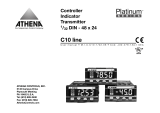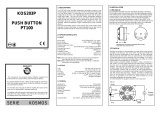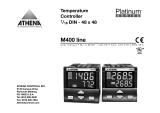Page is loading ...

Two alarms indicator
1/8DIN - 96 x 48
J1 line cc
U se r Manual • 09 702 • Co de : ISTR_M_J1 _E_0 4_--
J1 EN-ed3 17-02-2009 15:05 Pagina 1
ISO 9001
Certifi e d
Ascon Tecnologic srl
viale Indipendenza 56, 27029 Vigevano (PV)
Tel.: +39-0381 69 871 - Fax: +39-0381 69 8730
Sito internet: www.ascontecnologic.com
Indirizzo E-Mail: [email protected]

Two alarms indicator
1/8DIN - 96 x 48
J1 line cc
J1
12
1406.3
J1 EN-ed3 17-02-2009 15:05 Pagina 1

2
Information
cc
NOTES
ON ELECTRIC
SAFETY AND
ELECTROMAGNETIC
COMPATIBILITY
Please, read these instructions carefully before proceeding with the installation of the
controller.
Class II instrument, rearl panel mounting.
This indicator has been designed in compliance with:
Regulations on electrical apparatus (appliance, systems and installations) according to
the European Community directive 73/23/EEC amended by the European Community direc-
tive 93/68/EEC and the Regulations on the essential protection requirements in electrical
apparatus EN61010-1: 93 + A2:95.
Regulations on Electromagnetic Compatibility according to the European Community
directive #89/336/EEC, amended by the European Community directive #92/31/EEC,
93/68/EEC, 98/13/EEC and the following regulations:
Regulations on RF emissions
EN61000-6-3: 2001 residential environments
EN61000-6-4: 2001 industrial environments
Regulation on RF immunity
EN61000-6-2: 2001 industrial equipment and system
It is important to understand that it’s the responsibility of the installer to ensure compliance
with the regulations on safety requirements and EMC.
The device has no user serviceable parts and requires special equipment and specialised
engineers. Therefore, a repair cannot be carried out directly by the user. For service or repair,
contact the manufacturer or your sales represenattive.
All the information and warnings about safety and electromagnetic compatibility are
marked with the Bsign, at the side of the note.
J1 EN-ed3 17-02-2009 15:05 Pagina 2

3
Main universal input
Resources
IN
Modbus RS485
Parameterisation
Supervision (option)
J1
12
12
NO/NC
NO/NC
Special functions
OP1
OP2
Alarms
Operating mode
OP1 OP2
Table of contents
TABLE OF CONTENTS
1INSTALLATION ...................................................Page 4
2ELECTRICAL CONNECTIONS .............Page 8
3PRODUCT CODING ......................................Page 14
4OPERATIONS......................................................Page 18
5DISPLAYS...............................................................Page 28
6COMMANDS........................................................Page 29
7TECHNICAL SPECIFICATIONS ...........Page 31
option
J1 EN-ed3 17-02-2009 15:05 Pagina 3

4
1- Installation
1INSTALLATION
Installation must only be carried out by
qualified personnel.
Before proceeding with the installation of this
indicator follow the instructions illustrated in
this manual with particular attention to the
installation precautions marked with the
Bsymbol, related to the European
Community directive on electrical protection
and electromagnetic compatibility.
B
To prevent hands or metal touching parts
that may be electrically live, the indicators
must be installed in an enclosure.
IP 20 Terminal block
EN61010 - 1
(IEC1010 - 1)
Product code label
Sealing front panel gasket
Mounting clamps
Front panel
IP65 protection
EN 650529 (IEC 529)
Panel
surface
1.1 GENERAL DESCRIPTION
J1 EN-ed3 17-02-2009 15:05 Pagina 4

5
1- Installation
1.2 DIMENSIONAL DETAILS 1.3 PANEL CUT-OUT
48 mm
1.89 in
110 mm
4.33 in
10 mm max.
0.39 in max.
96 mm
3.78 in
10 mm max.
0.39 in max.
45+0.6mm
1.78+0.023in
65mm min.
2.56 in min.
92+0.8 mm
3.62+0.031 in
113 mm min.
4.45 in min.
J1 EN-ed3 17-02-2009 15:05 Pagina 5

6
1 - Installation
Operating conditions
MAltitude up to 2000 m
TTemperature 0…50°C [1]
%Rh Relative humidity 5…95 % non-condensing
1.4 ENVIRONMENTAL CONDITIONS B
Special conditions
MAltitude > 2000 m
TTemperature >50°C
%Rh Humidity > 95 %
PConducting atmosphere Use filter
Warm up
Use forced air ventilation
Use 24Vac supply version
Suggestions
Forbidden Conditions D
CCorrosive atmosphere
EExplosive atmosphere
UL note
[1] Operating surrounding temperature
0…50°C
J1 EN-ed3 17-02-2009 15:05 Pagina 6

7
1
3
2
2
1
2
1
12
1.5.1 INSERT
THE INSTRUMENT
1Prepare panel cut-out
2Check-front panel gasket
position
3Insert the instrument through
the cut-out
1.5.2 INSTALLATION
SECURING
1Fit the mounting clamps as
shown
2Push the mounting clamps
towards the panel surface to
secure the instrument
1.5.3 CLAMPS
REMOVING
1Insert the screwdriver in the
clips of the clamps
2Rotate the screwdriver
1.5.4 INSTRUMENT
UNPLUGGING B
1Push and
2Pull forward to remove the
instrument
1.5 PANEL MOUNTING [1]
UL note
[1] For Use on a Flat Surface of a Type 2 and Type 3 ‘raintight’ Enclosure.
Electrostatic discharges can
damage the instrument
Before removing
the instrument
the operator must
discharge himself
to ground
1MΩ
1
1
2
1- Installation
J1 EN-ed3 17-02-2009 15:05 Pagina 7

2ELECTRICAL CONNECTIONS
2827 30
29
26
25 31 32
10 11 12
36
123
0,5
Nm
Rear
terminal
cover
Wire size
1 mm2 (18 AWG
Solid/Stranded) [2]
5.7 mm
0.22 in
8
Ø
L
15 screw terminals M3
Option terminals
Tightening torque 0.5 Nm
Phillips screw-driver PH1
Flat blade screw-driver
0.8 x 4 mm
Terminals
Pin connector
q1.4 mm 0.055 in max.
Fork-shape AMP 165004
Ø 5.5 mm - 0.21 in
Stripped wire
L 5.5 mm - 0.21 in
2.1 TERMINAL BLOCK [1] B
2 - Electrical connections
N
L
RS485
1
2
3
4
5
6
7
8
9
10
11
12
19
20
23
24
25
26
27
28
29
30
31
32
33
34
35
36
TC
mV
NC
C
NO
OP1
NO
C
OP2
C
24V—
OUT
A
b
B
RTD
13
14
15
16
17
18
21
22
N/C
N/C
N/C
N/C
N/C
N/C
N/C
N/C
N/C
N/C
N/C
N/C
N/C
N/C
N/C
N/C
N/C
N/C
N/C
N/C
N/C
UL notes
[1] Use 60/70 °C copper (Cu) conductor only.
[2] Wire size 1 mm2(18 AWG Solid/Stranded)
J1 EN-ed3 17-02-2009 15:05 Pagina 8

2827 30
29
26
25 31 32 33
10 11 12
123
0,5
Nm
2827 30
29
26
25 31 32 33
10 11 12
36
123
0,5
Nm
36
A B
DC
A B
DC
9
2 - Electrical connections
PRECAUTIONS B
Despite the fact that the instru-
ment has been designed to work
in a harsh and noisy environment
(level IV of the industrial standard
IEC 801-4), it is recommended
these following suggestions.
A
All the wiring must comply with
the local regulations.
The supply wiring should be rout-
ed away from the power cables.
Avoid using electromagnetic con-
tactors, power Relays and high
power motors nearby.
Avoid power units nearby, espe-
cially if controlled in phase angle
mode.
Keep the low level sensor input
wires away from the power lines
and the output wires.
If this is not feasible, use shield-
ed cables on the sensor input,
with the shield connected to
ground.
2.2 SUGGESTED WIRE ROUTING B
Conduit for low level sensor cables
A= Supply
B= Outputs
C= Analogue inputs
D= Serial Communications
Conduit for supply and output cables
J1 EN-ed3 17-02-2009 15:05 Pagina 9

10
Power
supply
switch
RS485
C
V ~
[3]
[6]
[6]
[5]
[5]
[5]
OP1
OP2
PTC
Alarm
Supervision
12
11
10
3
2
1
32
31
30
29
28
27
26
25
A
b
B
IN1
PT100
2 - Electrical connections
2.3 EXAMPLE OF WIRING DIAGRAM B
Notes:
1] Make sure that the power supply voltage is
the same as indicated on the instrument.
2] Switch on the power supply only after all
the electrical connections have been com-
pleted.
3] In accordance with safety regulations, install
a circuit breaker on the instrument power
supply line that is clearly identified with that
instrument (or group of instruments). The
breaker shall be easily accessible by the
operator.
4] The instrument is PTC protected. In case
of failure it is suggested to return the instru-
ment to the manufacturer for repair.
5] To protect the instrument internal circuits
use:
- 2 AT fuse for Relay outputs (220 Vac);
- 4 AT fuse for Relay outputs (110 Vac).
6] Relay contacts are already protected with
varistors.
Only in case of 24 Vac inductive loads,
use model A51-065-30D7 varistors (on
request)
J1 EN-ed3 17-02-2009 15:05 Pagina 10

11
2 - Electrical connections
Wire resistance
150Ωmax.
For 3 wires only.
Maximum line
resistance: 20Ω/line
Use wires of the same
length and 1.5 mm2
size.
Maximum line
resistance: 20Ω/line
10
11
12
A
B
A
R2
R1
10
11
12
A
b
B
11
12
2.3.1 POWER SUPPLY B
Switching power supply with mul-
tiple isolation and internal PTC
• Standard version:
nominal voltage:
100...240Vac (-15...+10%)
Frequency 50/60Hz
• Low Voltage version:
Nominal voltage:
24Vac (-25...+12%)
Frequency 50/60Hz
or 24Vdc (-15...+25%)
For better protection against
electrical interference, it is rec-
ommended not to connect the
ground clamp provided for civil-
ian installations.
2.3.2 MAIN UNIVERSAL INPUT B
A L-J-K-S-R-T-B-N-E-W thermocouple type
• Connect the wires with the polarity as shown;
• Always use compensation cable of the correct type
for the thermocouple used;
• The shield, if present, must be connected to a prop-
er ground.
B For Pt100 resistance thermometer
• If a 3 wire system is used, always use cables of the
same diameter (1mm2min.) (line 20 Ω/lead maximum
resistance);
• When using a 2 wires system, always use cables of the
same size (1,5mm2min.) and put a jumper between ter-
minals 11 and 12.
C For ∆T (2x RTD Pt100) Special
AWhen the distance between the indicator and the
sensor is 15 m using a cable of 1.5 mm2 size pro-
duces an error on the measure of 1°C (1°F).
R1 + R2 must be <320Ω
L
N
25
26
Included PTC
Supply
27
J1 EN-ed3 17-02-2009 15:05 Pagina 11

12
2 - Electrical connections
Note:
[1] Auxiliary power supply for external tran-
smitter 24Vdc ±20% /30mA max. with
no short circuit protection
D2 With 3 wire transmitter
Rj >10MΩ.
D1 With 2 wire transmitter
D For mA, mV 2.3.3 OP1 - OP2 B
OP1 SPDT relay output
OP2 SPST-NO relay output
External
shunt 2.5Ω
Transducer 24Vdc
4…20mA 36
11
12
[1]
mA
24Vdc
External
shunt 2.5Ω
Transmitter
4…20mA
PV 36
11
12
[1]
mA
2.3.4 ALARM OUTPUTS B
OP1 output
OP2 output
Fuse
Load
31
32
[1]
Fuse
Load
28
29
[1]
30
[1] Load
Vac
Fuse
NC
C
NO
Vac
Notes:
[1] Varistor for inductive load 24Vac only.
External
shunt 2.5Ω
mV mA
11
12
OP1 relay output:
• SPDT relay,
2A/250Vac for resistive load, fuse 2AT at
250Vac, (4A/120Vac, fuse 4AT at 120Vac).
OP2 relay output:
• SPST
N.O. relay,
2A/250Vac for resistive load, fuse 2AT at
250Vac, (4A/120Vac, fuse 4AT at 120Vac).
J1 EN-ed3 17-02-2009 15:05 Pagina 12

13
2 - Electrical connections
2.3.5 SERIAL COMMUNICATIONS
(OPTION) B
C
1
2
3
• Galvanic isolation 500Vac/1 min.
• Compliance to the EIA RS485 standard
for Modbus/Jbus
• Setting dip switches
J1 EN-ed3 17-02-2009 15:05 Pagina 13
APlease, read:
“gammadue® and deltadue®indica-
tor series serial communication and con-
figuration software” technical manual
1234
O
N
Position On Off
15 VDC Polarization
polarization excluded
2Termination Termination
inserted excluded
30 VDC Polarization
polarization excluded
-4 -

14
3 - Product coding
3PRODUCT CODING
The complete code is shown on the instru-
ment label.
The information about product coding is
accessible from the front panel by means of
the procedure described in section 5.2 page
28.
P/N : J1-3150-0000
CONF :
S/N : A0A-0450/2210
V~(L-N) : 100÷240V 50/60 Hz - 4W
B C D
J1
12
1406.3
L M NI
P Q RO
Basic product code (hardware)
Configuration code (software)
Instrument label
J1 EN-ed3 17-02-2009 15:05 Pagina 14

Relay - Relay 7
0
15
3 - Product coding
3.1 MODEL CODE
Line Basic Accessories Configuration
1st part 2nd part
J 1 A B C 0 -0 F G 0 /IL M 0
Model:
Line 1J
Power supply A
100...240Vac (-15...+10%) 3
24Vac (-25...+12%) or 24Vdc (-15....+25%) 5
The product code indicates the specific hardware configuration of the instrument that can be modified by authorized personnel only.
User manual F
Italian/English (std) 0
French/English 1
German/English 2
Spanish/English 3
Front panel colour G
Dark (std) 0
Beige 1
O P 0 0
-
RS485 Modbus/Jbus SLAVE 5
Serial Communications C
None 0
Outputs OP1 - OP2 B
None
J1 EN-ed3 17-02-2009 15:05 Pagina 15

16
3 - Product coding
A
If, when the indicator is pow-
ered up for the first time, the
display shows the following
message
it means that the indicator has
not yet been configured.
The indicator remains in stand-
by until the configuration code is
set correctly (pag. 24).
Conf
J1
12
3.2 CONFIGURATION CODING
A 4+4 index code follows the
model of the indicator.
The code has to be set to con-
figure the indicator
(see chapter 3.1 page 15)
E.g. Enter the code 0320 to choose:
- T/C type J input with range
0...600°C;
- Change the display color to red
when an alarm is active.
E.g. Enter the code 2300 to choose:
- AL1 absolute, active high;
- AL2 absolute, active low.
Index
1st part
of configuration
code
I L M N
0320
Index
2nd part
of configuration
code
O P Q R
2300
TC T Cu-CuNi 0
TC K Chromel-Alumel IEC584 0
TC S Pt10%Rh-Pt IEC584 0
Input type and range I
Dc input 0…50mV linear
TR Pt100 IEC751 0
1
Dc input 10…50mV linear 1
Custom input and range [1]
TR Pt100 IEC751 0
1
TC L Fe-Const DIN43710 0
-328…752 °F
TC J Fe-Cu45% Ni IEC584 0
32…2192 °F
32…2912 °F
-99.9…572.0 °F
-328…1112 °F
32…1112 °F
32…1112 °F
-200 …400 °C
0…1200 °C
0…1600 °C
Engineering and units
-99.9…300.0 °C
Engineering and units
-200…600 °C
0…600 °C
0…600 °C
6
5
4
6
5
4
3
2
1
0
L
TC R Pt13%Rh-Pt IEC584 0
32…2912 °F0…1600 °C 7
TC B Pt30%Rh
Pt6%Rh IEC584 0
32…3272 °F0…1800 °C 8
TC N Nicrhosil-Nisil IEC584 0
32…2192 °F0…1200 °C 9
TC E Ni10%Cr-CuNi IEC584 1
32…1112 °F0…600 °C 0
TC W3%Re-W25%Re 1
32…3632 °F0…2000 °C 2
TC W5%Re-W26%Re 1
32…3632 °F0…2000 °C 3
TC NI-NiMo18% 1
32…2012 °F0…1100 °C 1
[1] For instance, other thermocouples types, ∆T (with 2 PT 100),
custom linearisation etc.
J1 EN-ed3 17-02-2009 15:05 Pagina 16

17
3 - Product coding
Display mode
Green 0
Red 1
Red when alarm 1 (AL1) active 2
M
Deviation
Band
Alarm type and function
Non-active
Sensor break alarm
Absolute
6
5
4
3
2
1
0
7
Rate alarm (AL1 only)
Active High
Active Low
Active Out
Active High
Active Low
Active In
8 -
O
AL1
P
AL2
J1 EN-ed3 17-02-2009 15:05 Pagina 17

18
4 - Operation
J1
12
8.8.8.8.81.4.0.6.3
Over range Under range
Alarm acknowledge
Entry key for selection and value setting confirmation
Menu access
Min and Max. values display
Alarm status LEDs (reds)
ÅAL1 ON
ÇAL2 ON
88888_____ 88888
Input value [1]
In engineering uits
-----
Note:
[1] The colour of the dislplay is set through field mof the
Configuration Code (page 17).
4.1.1 KEY FUNCTIONS AND DISPLAY IN OPERATOR MODE
4OPERATIONS
J1 EN-ed3 17-02-2009 15:05 Pagina 18

19
4 - Operations
4.1.2 KEY FUNCTIONS AND DISPLAY IN PROGRAMMING MODE
A
The parameter setting procedure
has a timeout. If no keys are
pressed for, at least 30 seconds,
the indicator switches back, auto-
matically, to the operator mode
.
After having selected the para-
meter or the code, press $
and %to display or modify
the value (see page 20).
The value is entered when the
next parameter is selected, by
pressing the Rkey.
Until the $or %are
pressed or if you wait for 30 sec-
onds, the parameter value is not
inserted.
Pressing the íkey, the next
group of parameters is presented
on the display.
8.8.8.8.8
J1
12
Parameter Code/Value
Back to previous parameter
Entry key for selection
and value setting confirmation
Value modification
Access to the menu for:
Parameter setting
Configuration
J1 EN-ed3 17-02-2009 15:05 Pagina 19
/


